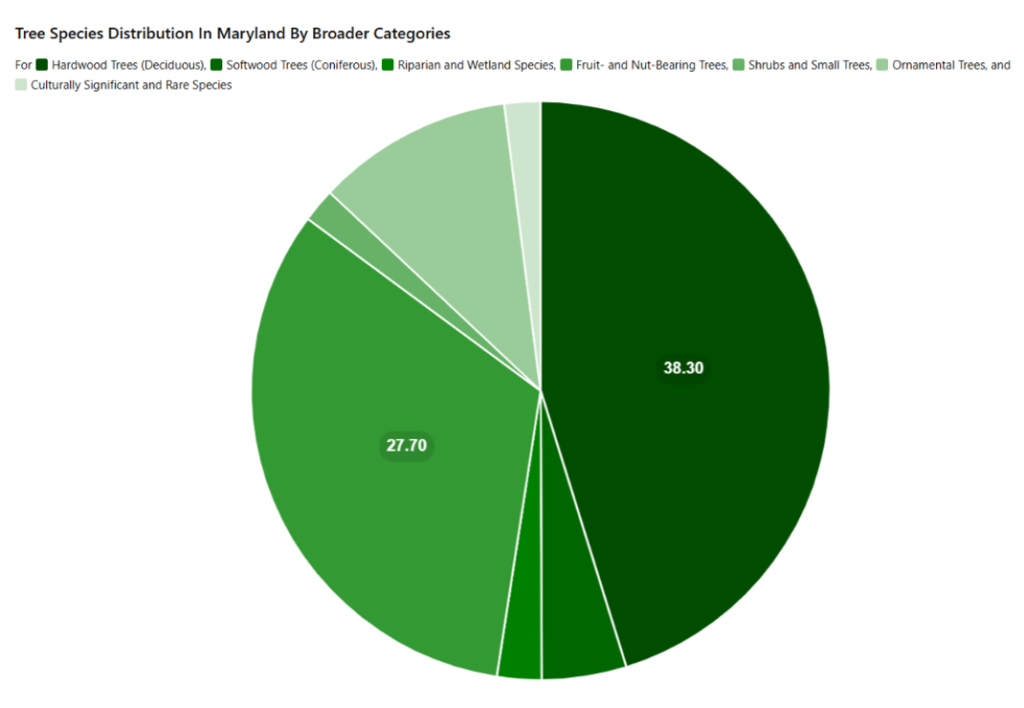Planting Trees in Maryland Forests

What Trees Grow in Maryland Forests?
Maryland’s forests are a tapestry of diverse ecosystems, home to a wide array of tree species that play critical roles in maintaining the state’s ecological balance. Reforestation in Maryland’s National Forests and protected lands is critical for addressing deforestation, habitat loss, and the effects of climate change. By supporting reforestation efforts, we help forested areas, particularly in riparian zones. From towering hardwoods like Red Oak and Tulip Poplar to resilient softwoods like White Pine and Norway Spruce, each species contributes to the health and sustainability of Maryland’s landscapes.
By analyzing the composition of tree species, we gain insight into the health of forest ecosystems and their ability to support wildlife, combat climate change, and protect water resources. For example, hardwood trees dominate Maryland’s forests, providing essential habitats for animals such as deer, squirrels, and migratory birds, while softwoods contribute to the structural integrity of ecosystems in areas prone to erosion. By analyzing the composition of tree species, we gain insight into the health of forest ecosystems and their ability to support wildlife, combat climate change, and protect water resources. For example, hardwood trees dominate Maryland’s forests, providing essential habitats for animals such as deer, squirrels, and migratory birds, while softwoods contribute to the structural integrity of ecosystems in areas prone to erosion.
Understanding the tree species composition in Maryland strengthens our ability to design effective reforestation programs tailored to the state’s unique ecological needs. By planting species like Tulip Poplar, White Oak, and Eastern Cottonwood, we ensure the resilience of Maryland’s forests while preserving their natural beauty. Join the effort to restore Maryland’s landscapes.
Chesapeake Bay Environments
This project seeks to improve the water quality of the main stem of the Chesapeake Bay by reducing non-point source pollution, namely inputs of nitrogen, phosphorus, and suspended solids. To achieve this goal, we are requesting funding to re-establish native forests on 89.7 acres of private and public land in Garrett, Allegany, and Washington Counties, Maryland, including 24.6 acres of new riparian buffer and 19.9 acres of formerly mined lands. Project funds will be used to secure a private contractor to reforest sites located on 8 properties across Garrett, Allegany, and Washington Counties according to shovel-ready planting plans that have been developed by the DNR Forest Service. The locations on the Antietam National Battlefield and within the Ridenour Swamp Wildlife Management area will mean that the public will have the opportunity to benefit from the added aesthetic and ecological values of those plantings.
This project aims to address the levels of nitrogen, phosphorus, and sediment which exist in the Chesapeake Bay through the reforestation of sites located across western Maryland. The planting of 24.6 acres of new riparian buffer will be of paramount importance to addressing several major conservation efforts, including improving the water quality of the local watersheds, erosion control, flood mitigation and storm water management, carbon sequestration, and young forest habitat restoration. The young forest habitat restoration is especially important for promoting population rebounds of vulnerable and threatened species such as the Golden-winged and Cerulean warblers. The plantings will contribute towards Maryland’s goal for no net loss of forests, and Maryland Stream ReLeaf prioritization in floodplains and headwaters. This project will also address the 2014 Bay Agreement goals of promoting abundant life, clean water, increasingly engaged communities, and climate change resiliency in the Chesapeake Bay watershed through the establishment of young forest habitat in western Maryland in tandem with our proposed radio broadcast, social media, and in-person outreach. Specifically, this project supports the long-term goal of 70% riparian forest.
Leaving a Legacy in Maryland
Planting trees with The Trees Remember in Maryland is more than an act of environmental restoration. Your contribution is a heartfelt way to honor loved ones and celebrate life’s milestones. Every tree planted is a living legacy. Help us restore vital ecosystems, protect wildlife habitats, and combat climate change across Maryland’s National Forests. Support reforestation initiatives today and help protect the future of Maryland’s forests.
